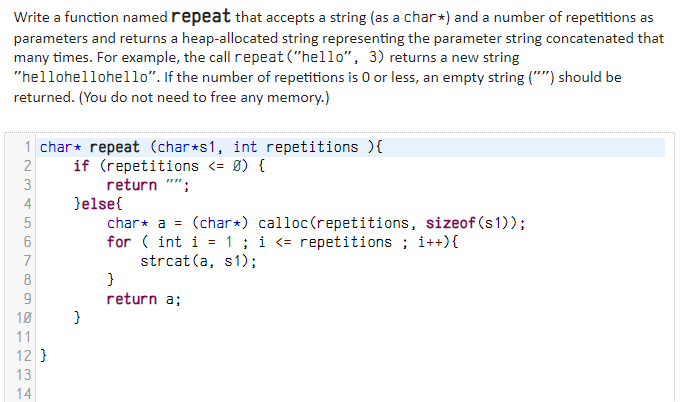Write a function named repeat that accepts a string (as a char*) and a number of repetitions as parameters and returns a heap-allocated string representing the parameter string concatenated that many times. For example, the call repeat("hello", 3) returns a new string "hellohellohello". If the number of repetitions is 0 or less, an empty string ("") should be returned. (You do not need to free any memory.)
Write a function named repeat that accepts a string (as a char*) and a number of repetitions as parameters and returns a heap-allocated string representing the parameter string concatenated that many times. For example, the call repeat("hello", 3) returns a new string "hellohellohello". If the number of repetitions is 0 or less, an empty string ("") should be returned. (You do not need to free any memory.)
Computer Networking: A Top-Down Approach (7th Edition)
7th Edition
ISBN:9780133594140
Author:James Kurose, Keith Ross
Publisher:James Kurose, Keith Ross
Chapter1: Computer Networks And The Internet
Section: Chapter Questions
Problem R1RQ: What is the difference between a host and an end system? List several different types of end...
Related questions
Question
Please give answer of that code

Transcribed Image Text:Write a function named repeat that accepts a string (as a char+) and a number of repetitions as
parameters and returns a heap-allocated string representing the parameter string concatenated that
many times. For example, the call repeat ("hello", 3) returns a new string
"hellohellohello". If the number of repetitions is 0 or less, an empty string ("") should be
returned. (You do not need to free any memory.)
1 char* repeat (char*s1, int repetitions ){
if (repetitions <= Ø) {
2
3
return
4
}else{
char* a = (char*) calloc(repetitions, sizeof (s1));
for ( int i = 1; i <= repetitions ; i++){
strcat (a, s1);
7
8
return a;
10
11
12 }
14
N 3 4
Expert Solution
This question has been solved!
Explore an expertly crafted, step-by-step solution for a thorough understanding of key concepts.
This is a popular solution!
Trending now
This is a popular solution!
Step by step
Solved in 4 steps with 2 images

Recommended textbooks for you

Computer Networking: A Top-Down Approach (7th Edi…
Computer Engineering
ISBN:
9780133594140
Author:
James Kurose, Keith Ross
Publisher:
PEARSON

Computer Organization and Design MIPS Edition, Fi…
Computer Engineering
ISBN:
9780124077263
Author:
David A. Patterson, John L. Hennessy
Publisher:
Elsevier Science

Network+ Guide to Networks (MindTap Course List)
Computer Engineering
ISBN:
9781337569330
Author:
Jill West, Tamara Dean, Jean Andrews
Publisher:
Cengage Learning

Computer Networking: A Top-Down Approach (7th Edi…
Computer Engineering
ISBN:
9780133594140
Author:
James Kurose, Keith Ross
Publisher:
PEARSON

Computer Organization and Design MIPS Edition, Fi…
Computer Engineering
ISBN:
9780124077263
Author:
David A. Patterson, John L. Hennessy
Publisher:
Elsevier Science

Network+ Guide to Networks (MindTap Course List)
Computer Engineering
ISBN:
9781337569330
Author:
Jill West, Tamara Dean, Jean Andrews
Publisher:
Cengage Learning

Concepts of Database Management
Computer Engineering
ISBN:
9781337093422
Author:
Joy L. Starks, Philip J. Pratt, Mary Z. Last
Publisher:
Cengage Learning

Prelude to Programming
Computer Engineering
ISBN:
9780133750423
Author:
VENIT, Stewart
Publisher:
Pearson Education

Sc Business Data Communications and Networking, T…
Computer Engineering
ISBN:
9781119368830
Author:
FITZGERALD
Publisher:
WILEY